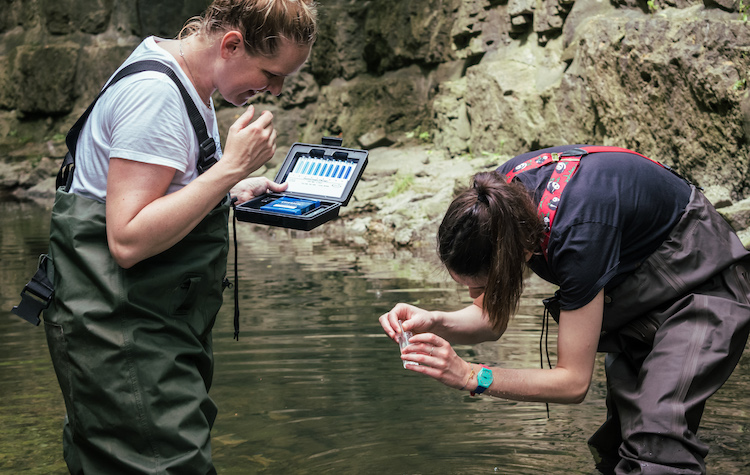Kirsten Grant, General Science co-editor
With millions of lakes in Canada, monitoring water quality is no small feat. Canada’s vastness means it’s impossible to collect data everywhere. The situation is made ever more difficult by a lack of funding for long-term environmental monitoring.
But Water Rangers Executive Director Kat Kavanagh says citizens can play a part in meeting that challenge. In conversation, Kavanagh’s optimism and enthusiasm for citizen science water quality monitoring is contagious. “People are hungry [for knowledge] and want to protect what they love,” she says. From Ottawa to Iqaluit, citizen scientists with Water Rangers are helping us understand our water quality. Citizens are the eyes and ears of scientists on the ground, and notice when things change in their own communities.

Kat Kavanagh, Executive Director of Water Rangers, and a volunteer, using a test kit to test water quality. Photo by Kat Kavanagh, used with permission.
Bridging technology and water
Water Rangers was the natural extension of Kat and her dad’s experience at Lake McGlashan, in Val-Des-Monts, Quebec. Spending time swimming and canoeing at the lake every summer, Kat and her dad developed a deep connection to the surrounding area and its waters. They began testing the lake’s water quality out of personal interest in their favourite place. “We’re doing this because we care,” says Kavanagh. They thought that there were probably other Canadians around the country who cared as much about the health of their local lakes as they did. From there, Water Rangers was born.
Through discussions with local community members, Kavanagh found there was a lack of data about water bodies that interested her, and community members were struggling to feel engaged. With a background in technology and a love for water, she pitched the idea of Water Rangers as a data platform for citizen science and won the 2015 Aquahacking competition, kickstarting Water Rangers as a unique non-profit social enterprise.
The value of the baseline
Our lakes are facing many stressors, from land-use to climate change.
“Without this baseline data, how do we know that something is changing?” asks Kavanagh.
Without enough data, determining how these threats impact our water is tricky. A recent Watershed report by the World Wildlife Fund (WWF) ranks the health of Canadian watersheds along with the threats they face. In the Great Lakes watershed threats that include pollution, habitat fragmentation, overuse of water, and invasive species are scored as very high. But the overall health of this watershed is ranked as “data deficient” because there are limited data on water flow, water quality, fish, and benthic invertebrates.
The story is similar across the country, with the report noting that publicly available water quality data in Canada is lacking. Kavanagh is optimistic that citizens and community groups can help bridge this gap.
Data sharing – two ways
Water Rangers is unique in that it provides a data platform where anyone can upload observations and use available data. The platform is a collaboration between conservation authorities, research groups, local water hubs, governments, and the WWF. It is a place where data are collected and shared. Users can view local observations and learn about groups in their area through Water Rangers’ online interactive map.
This collaborative approach is driven by Kavanagh’s vision of building collective capacity in water quality monitoring. Water Rangers offers test kits to help standardize data collection among volunteers.
A conversation starter

Water Rangers volunteers teaching students to measure water turbidity using Secchi disks. Photo by Kat Kavanagh, used with permission
Water stewardship starts with a conversation. Being in a lake or a stream with a test kit can be that conversation starter. While out testing water, many volunteers are approached by people interested in what they’re doing.
This has led to Water Ranger volunteers teaching others how to monitor water quality, and even spending the day water quality testing with other community members. Citizen scientists who monitor regularly are more aware of changes in their water quality and feel more comfortable talking about it. The feeling of being empowered, and developing the confidence to discuss the water quality of lakes they care about, is one of the key things Water Rangers’ volunteers take away from their efforts.
Be a Water Ranger
You don’t need a Water Rangers kit to start testing and sharing data. “You can get started with a pool thermometer,” says Kavanagh.
Students, from elementary school to university, have used these kits for hands-on learning and as affordable training tools in the classroom. Youth groups, lake associations, and outdoor enthusiasts have all participated. Water Rangers offers field guides and short videos and webinars to train volunteers about accurate data collection. You can even see if there is a kit lending program near you.
When asked how to prioritize water quality monitoring, Kat says, “The dream is not to say ‘only monitor these ones,’ it’s to say ‘all of them.’”
~30~





